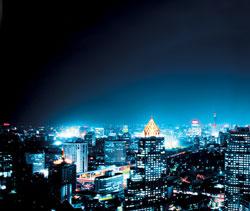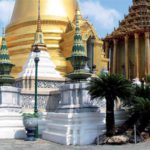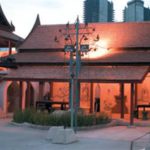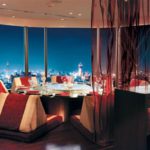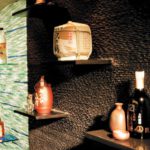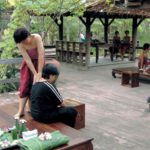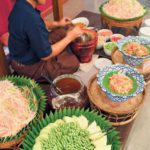With the exotic scents of jasmine, gardenias and orchids filling the air, and food that has to be tasted to be believed, Bangkok is a vibrant, colourful sensory experience
KERRY PHILLIPS
Touching down at Bangkok’s brand new Suvarnabhumi Airport was as much a novelty as flying Thai Airways, where their “smooth as silk” logo is quite apt for the 11-hour flight from Johannesburg. As we boarded the plane, we were directed to the left and gleeful smiles spread across our faces as we settled into our Royal Silk Class, or business class, seats.
The journey was a pleasure as we enjoyed five-star service from the cabin attendants and meals that bore no resemblance to typical airline food – a noteworthy introduction to Thai food for those who hadn’t experienced it before. Suvarnabhumi Airport is an extension of this experience, and the US billion project means Bangkok can now boast the largest terminal building and tallest control tower in the world.
I’d been warned about the heat in Bangkok but it was still a shock when we walked out of the airport. Even though our guide assured us that it was winter, the temperatures hovered around 34ºC every day, and with the humidity it felt much hotter. We were grateful to collapse into our air-conditioned car for our transfer to the magnificent Banyan Tree hotel, where again our expectations were exceeded. An all-suite hotel, the Banyan Tree Bangkok gives new meaning to luxury.
The hotel boasts some of the finest restaurants in Bangkok, with six to choose from, as well as the option of a dinner cruise on the Chao Phraya River. If time is short and you’re unable to visit all six, then you should certainly try Vertigo, the tallest open-rooftop restaurant in Asia, Saffron, which serves contemporary Thai cuisine, and Pier 59, an ultra-chic seafood restaurant and wine bar. Were it not for the fact that there’s an exciting city waiting to be explored, it would be easy not to set foot outside the door. The Banyan Tree hotels, of which there are eight worldwide, are also renowned for their spas.
It was with a great deal of anticipation that I headed off for a Thai massage, which left me feeling blissed out and ready to lay my head on the comfy pillow I’d selected from a choice presented to me at check-in. However, time was short and there was a lot of sightseeing and shopping to be done. Like Los Angeles, Bangkok is known as the City of Angels. Unlike LA, however, it really is inhabited by angels or, at the least, by what must be the friendliest and most helpful people on earth.
The Thais are gentle and softly spoken, and they greet everyone by placing their hands together and making a small bow. Many of the world’s biggest cities are notoriously dirty, smelly, noisy and full of exhaust fumes, and again Bangkok differs. There are approximately 12 million people living in Bangkok and the traffic is horrendous, yet the city is more peaceful than you’d expect.
Displays of anger, rudeness and impatience are frowned upon, so there’s no road rage, raising of voices, cursing or blowing of hooters. For someone used to Joburg traffic jams, it was a pleasant surprise. Despite the heavy traffic, getting around Bangkok couldn’t be easier and like most things in the city, it doesn’t cost too much either. You can jump on the super-efficient skytrain, a tuk-tuk or, if you’re not too weighed down by shopping bags, flag down a motorcycle taxi. It’s a faster option as you can weave in and out of the traffic.
Should your destination be close to the river, a trip in a long boat is a scenic yet speedy way to move around. A word of advice though: should you opt for a tuk-tuk – which you should at least once, just for the experience – tell the driver very firmly when you board that you do not want to be taken to any jewellery shops; many drivers are paid a commission by shop owners to bring tourists to their stores.
A visit to the Grand Palace, a series of buildings occupied by the King of Thailand from the 18th to the 20th century, and where all that glitters really is gold, is high on every tourist’s list. However, there are a few other things you should do in Bangkok. One of these is to take a tour of the khlongs, the canals that used to criss-cross Bangkok, earning it the nickname of Venice of the East. Today, many of the khlongs have been converted to streets but the Thonburi side of Bangkok, west of the Chao Phraya River, still comprises waterways and offers a fascinating insight into a different way of life in Bangkok.
Like many things in the city, there is a strong juxtaposition of old and new, rich and poor – ancient temples and traditional wooden houses nestle between modern skyscrapers; market stalls are set up next to designer shopping malls; and along the khlongs, majestic homes sit alongside rundown shacks. A stop for a cooking lesson at traditional cook Surajit Amphansaeng’s house, Ruen Khun Yaai, was a delight. Here visitors can see how the Thais live.
We enjoyed a concert by her son, who played the ranad tum, a Thai xylophone, and a kim, a hammered dulcimer, before we were shown around the house that has been in her husband’s family for three generations. Another must on your to-do list is a visit to the Thailand Cultural Centre in Bangkok’s Huay Kwang area. Not usually on the tourist route, it’s a cultural complex with three restaurants, a few shops, a theatre and a fascinating village depicting the four regions of Thailand, with their traditional houses and lifestyles, as well as arts and crafts demonstrations.
Make sure you catch the show in the 2 000-seat theatre, Siam Niramit – Journey to the Enchanted Kingdom of Siam, a dance spectacular of Thai history, traditions and mythology. It’s one of the largest stage productions in the world, with 150 performers, 500 costumes, wonderful special effects and even two live elephants. The majority of tourists visiting Bangkok get excited by the shopping, and with good reason, as you can get everything from pricey designer items in the exclusive shopping malls to cheap knock-offs in the markets. Most tourists head straight to MBK, where prices are reasonable and you can buy anything you can think of.
A visit to the glossy Siam Paragon centre brought out the fashionista in each of us, as we wistfully tried on Jimmy Choos, coveted the Chloé dresses and shopped up a storm at Zara. Bangkok is renowned for its markets and it’s easy to see why: they’re plentiful, and the prices are very friendly to our rand, especially after you’ve bargained with the vendor. Unfortunately we weren’t able to pay a visit to the renowned Chatuchak weekend market, but an evening at Patpong’s vibrant night market was fun and fruitful. Although the quality of the goods is dubious and everything is imitation, it didn’t stop us emptying our wallets for “Louis Vuitton” bags and “Cartier” watches.
Patpong is also Bangkok’s red-light district, but while there are prostitutes aplenty and men trying to entice tourists into the sex shows, it is possible to ignore the seedy side. Food is a favourite reason for a visit to Thailand, and good food can be found everywhere, from the numerous street stalls where you can get great dishes that are perfectly safe to eat and very cheap too, to the many restaurants and hotels that offer fine dining.
Cooking lessons are a popular activity with most hotels offering courses lasting from a morning to a few days. If you’re lucky they include a visit to the food market. If not, add the Bangrak food market to your itinerary. It’s a foodie’s paradise where you can get fruit, vegetables, meat and seafood as well as the skinned frogs that both fascinated and repulsed us. It also has a great flower market. As a Thai food lover, my taste buds were in their element in Bangkok, but it was the fruit that enthralled me. Tropical fruits, some of which I had never encountered before, with the most vibrant colours, aroma and taste, were served at every meal as part of the dish, dessert and presentation, which, to the Thais, is as important as the flavour.
Fruit carving is a Thai art and often drew gasps of admiration when we saw what can be done with mango and pineapple. Pitaya (commonly known as dragon fruit) quickly became my favourite with its bright purple skin and delectable white fruit not unlike kiwi. Tamarind, coconut, banana, cantaloupe, mango, pomelo and starfruit were plentiful. With such a healthy diet, it soon became clear why the Thais are small people. It’s a diet I could become accustomed to. In fact, life in Bangkok is something I could very easily get used to. Friendly people, great shopping, an efficient public transport system and air fragranced with jasmine, gardenias and orchids everywhere you go… A Land of Smiles indeed

